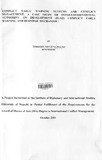| dc.description.abstract | The post- cold war period has witnessed the emergence of conflict early and response system. Their emergence has been necessitated by the need to prevent conflicts before they escalate into violence. This is because it is easier to manage conflict in its early stages prior to eruption. To effectively do this, there is a need for a system capable of alerting policy makers on an impending violent conflict and where possible craft intervention strategies.
In Africa, a continent which has witnessed high levels of violent conflicts, the African Union has established a Continental Early Warning system. Similarly, sub-regional organizations have set up such systems although different regions have made varied progress. In the Hom of Africa, the premier sub-regional organization-Inter-governmental Authority on Development (IOAD)-has set up an elaborate Conflict early Warning and Response Mechanism (CEWARN). The mechanism remains the most advanced in Africa. However despite this position a question remains whether conflict early warning systems do playa role in conflict management. Using CEW ARN as case study the research has endeavored to answer this question.
Using a conceptual framework which has analytically categorized the operation of these systems into two, that is, early warning and early response and identified the key variables involved in either as well as activities undertaken, the study has comprehensively analyzed the contributions of CEWARN to lOAD's conflict management. Drawing from data gathered through desk top and interview methods, the study shows that there exist a gap between the expectations and reality of early warning and response systems. They have made modest contribution to conflict management. This is because they are hampered by challenges ranging from been founded on weak national and regional structures, resources constraints and lack of response capacities and political commitment by policy makers.
The study concludes that for early warning and response systems to live up to their mandate, there must be commitment by member states. States need not only to ratify or accede to regional treaties but also implement them in good faith. Essentially they should walk the talk and back up regional peace and security projects with all the resources-material or otherwise-that they need to function effectively. | en_US |

